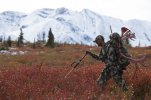Trophy Hunting’s Unlikely Boom
Amid growing outrage over kill photos, the sport reinvents itself as a test of endurance
ENLARGE
Jason Hairston hikes the Alaskan wilderness during a mountain caribou hunt. PHOTO: PAUL BRIDE
By
KEVIN HELLIKER
Dec. 18, 2015 7:12 p.m. ET
After retiring from baseball this autumn with three World Series rings, the former San Francisco Giants relief pitcher Jeremy Affeldt set his sights on another kind of sports trophy: a grizzly bear. But upon calling a hunting guide in Alaska that specializes in trophy game, Affeldt got a surprise: “The first spot I could get was 2017,” he said.
After decades of declines in the number of American hunters, their ranks have inched up this century, according to U.S. Fish & Wildlife Service surveys. But unlike a half century ago, when most hunters made do with rabbits, squirrels and birds, today’s growth is being fueled by one segment in particular: Big game. Especially popular are high-end guided hunts like the 10-day, $32,000-plus pursuit of moose and grizzly that Affeldt signed up for.
Not only do these hunts promise the chance to land a big trophy—a rack of elk antlers for the library wall, for instance—they’re also tapping into the same extreme fitness boom that has fueled rising participation in triathlon and marathon. “We hiked 10 miles a day through the mountains carrying a 50-pound pack—and that weight doubled after we made a kill,” says Graham Hobbs, a New York real estate executive who ran a marathon and lifted weights to prepare for a 10-day Alaska hunt this September.
This development comes at a time when hunting in general, and big-game hunting in particular, has been a target of withering attacks from critics who consider it cruel and sadistic. Last summer when a Minnesota dentist killed a lion in Zimbabwe that was being tracked and studied as part of an Oxford University study—and was known to researchers as Cecil—the reaction on social media was overwhelmingly negative, sparking protests and angry editorials worldwide.
The dentist, Walter Palmer, faced no charges but officials in Zimbabwe said this fall they would pursue charges against the hunt’s guides, who they said illegally lured the lion out of protected territory. Palmer could not be reached for comment.
Other hunters whose trophy kill photos have been passed around on social media have faced similar waves of outrage: After Outdoor Channel star Eva Shockey posted photographs of a bear shot legally in North Carolina late last year, she received thousands of hostile comments across social media, including death threats. Shockey defended herself in various media appearances, gaining an even larger following among hunters.
Hunting advocates say most game animals in the U.S. have experienced dramatic growth in recent decades thanks to government management efforts that are funded by donations from and taxes imposed on hunters.
Trophy hunts are a boon to companies like 4-year-old KUIU, a maker of light-weight yet warm hunting apparel and gear, whose sales are doubling every year, to $30 million in 2015, the company said. The number of hunters attending, and companies exhibiting, at next month’s Wild Sheep Foundation convention has grown sharply, organizers say, and prices for special hunting permits (called tags) that are auctioned off at the event are fetching hundreds of thousands of dollars. “There’s definitely a driving interest in extreme hunting,” says Gray N. Thornton, chief executive of the foundation.
Hunters of every kind can come home empty handed. But the failed pursuit of rabbits and squirrels doesn’t cost tens of thousands of dollars. Dan Burton has taken more than 25 hunting expeditions with Lance Kronberger of Freelance Outdoor Adventure in Alaska. On about one out of three of those trips, he said, he didn’t take shots at any of the animals they saw after deeming them too small or too young.
ENLARGE
Jason Hairston on a hunt in Alaska. PHOTO: PAUL BRIDE
Burton, 62, the owner of Burton Lumber in Salt Lake City, says those trips are just as gratifying as those where he did take home trophies. “Hunting is a huge motivation for me to get outdoors and stay in physical and mental shape,” he says.
A hunt with an Alaska guide typically begins with a plane dropping the hunters in a wilderness area too remote to reach by foot or car. Then come high-altitude hikes, often in inclement weather. Until the skies clear, there’s no hope of a plane ride back. “There’s no way out of the elements,” says Burton. “You’re in your third day of a driving rain storm. All your gear is wet. Your sleeping bag is damp. And you know the next day you’re going to get up and do it all again.” He pauses. “Those are the things that make the hunt good.”
“Very few guys can take it 10 days,” says Kronberger, who sends his clients a workout routine several months ahead of a hunt. “After five or six days, even if they still have tags in their pockets”—meaning nothing has been killed—“they say, ‘I want to go home. I’ve had enough of being miserable.”
Mountain climbers experience similar challenges, of course. But once a kill is made, the weight of a hunter’s backpack is doubled or tripled. That prospect prompts Affeldt to vow he will get into better shape than professional baseball required. “I don’t want to be one of those guys who needs a guide to help him with his pack,” says Affeldt.
KUIU owner Jason Hairston says one of his best hunts in Alaska took place in an ice storm that required him and his father to wade for days through an ice-choked river to their point of rendezvous.
“My dad got frostbite and lost two fingertips. We all got frostbite on our feet from being in the water all day,” says Hairston. “It was awesome. I loved it. To know that you can make do in conditions that harsh, I thought it was a big success.”
Kevin Helliker
Source: Wallstreet Journal
http://www.wsj.com/article_email/trophy-huntings-unlikely-boom-1450483941-lMyQjAxMTE1ODM1MDEzODA4Wj





